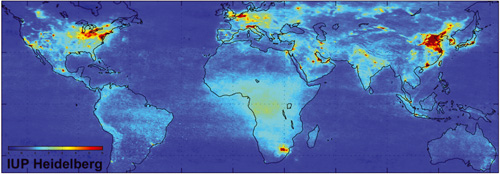Description
‘Atmospheric chemistry instruments’ is used here to describe a range of different types of instruments using various techniques, and different parts of the electromagnetic spectrum, to undertake measurements of composition of the atmosphere. Each atmospheric gas is characterised by its ‘absorption’ and ‘emission’ spectra which describe how the molecules respond to different frequencies of radiation. Remote sensing instruments exploit these ‘signatures’ to provide information on atmospheric composition, using measurements over a range of wavelengths, between UV and microwave.
Atmospheric absorption tends to be dominated by water vapour, carbon dioxide, and ozone, with smaller contributions from methane and other trace gases. Relatively broadband instruments can be used for measurements of the dominant gases, but high spectral resolution sensors are needed to make measurements of other species, since they produce weaker signals, and these must be discriminated from the signals from more abundant gases.
These instruments are typically operated in either:
- nadir-viewing mode: looking directly down to measure the radiation emitted or scattered in a small sold angle centred around a measurement point on the Earth – with resulting high spatial resolution in the horizontal direction, but limited vertical resolution; or
- limb-viewing mode: scanning of positions beyond the horizon to observe paths through the atmosphere at a range of altitudes – providing high vertical resolution (few km) and limited horizontal resolution (10’s of kms) – and particularly useful for studying the middle atmosphere.
Applications
The earliest atmospheric chemistry instruments were deployed to help international understanding of stratospheric ozone depletion, and succeeded in producing startling and convincing evidence of the growth of the Antarctic ozone hole. Many of the current and planned instruments continue to provide more sophisticated and accurate information on ozone chemistry in the atmosphere, including relating to gases and radicals which impact on the ozone cycle.
In addition to ozone measurements, instruments are now available which offer information on a range of different trace gases, including key greenhouse gases and chemically active gases which affect the environment. The capability to provide a global picture of the atmosphere, and how it is changing on a daily, seasonal and geographical basis is ensuring demand for these instruments in a wide range of applications, including: pollution monitoring; climatology, including studies of the carbon cycle and support to policy-making processes such as the Kyoto Protocol; volcanic eruption monitoring; and operational meteorology.
The trend towards improved measurement resolutions and accuracies, profiling measurements (rather than total column measurements), and extended capability in the Upper Troposphere/Lower Stratosphere (UTLS) will further extend the value of these instruments in the coming years for monitoring air quality and modelling atmospheric processes.
| Current & planned instruments ACE-FTS APS EPIC GHG Sensor GOME GOME-2 GOMOS HALOE HiRDLS HRDI IASI MAESTRO MASTER MIPAS MLS MOPITT OCO OMI OMPS OP OSIRIS SABER SAGE II SAGE III SBUV/2 SCIAMACHY SFM-2 SMR TES TOM WINDII |

Atmospheric transmittance and radiance for UV to IR regions

A global air pollution (nitrogen dioxide) map produced by SCIAMACHY on ENVISAT
| ACE-FTS: www.ace.uwaterloo.ca GOMOS/MIPAS/SCIAMACHY: envisat.esa.int/instruments/index.html IASI: smsc.cnes.fr/IASI/ HIRDLS/MLS/OMI/TES: eos-aura.gsfc.nasa.gov/instruments/ |